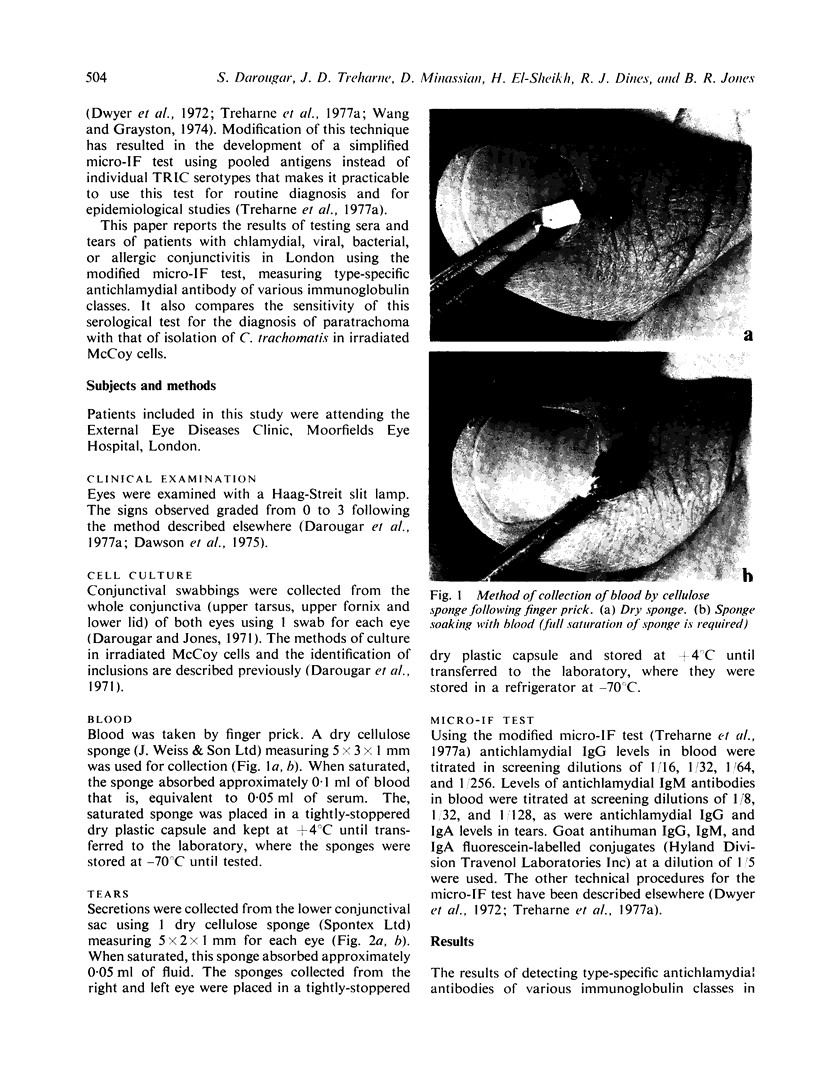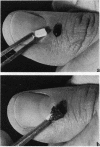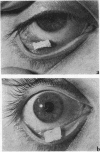Abstract
A rapid serodiagnostic test for the diagnosis of paratrachoma (TRIC ophthalmia neonatorum, inclusion conjunctivitis, TRIC punctate keratoconjunctivitis, and trachoma of sexually transmitted origin) has been developed. The technique is based on using a modified micro-immunofluorescence test for detecting antichlamydial IgG and IgM in the blood and IgG and IgA in tears. The blood samples are collected on cellulose sponges after a finger prick, and tears are collected by introducing small sponges into the lower conjunctival fornix of the eye. The blood and tear samples collected in this way could be sent to the diagnostic laboratory by post without special arrangements for cold storage. In general the presence of antichlamydial IgG at a level of greater than or equal to 1/32 or IgM at a level of greater than or equal to 1/8 in blood and antichlamydial IgG or IgA at a level of greater than or equal to 1/8 in tears was closely associated with ocular paratrachoma. The combined results of the micro-IF test of blood and tears has yielded the highest rate of positivity (90%). In patients with acute untreated paratrachoma the sensitivity of this test was similar to that of irradiated McCoy cells. In patients with a milder infection receiving antibiotics the sensitivity of the serodiagnostic test was superior to that of the cultural test. The high sensitivity and specificity of this rapid, simple and inexpensive serodiagnostic test for the diagnosis of chlamydial ocular infections, coupled with simple and practical methods of collection and transport of blood and tear specimens, offer advantages over cultural tests for routine diagnosis and study of chlamydial ocular infections.
Full text
PDF





Images in this article
Selected References
These references are in PubMed. This may not be the complete list of references from this article.
- Darougar S., Jones B. R. Conjunctival swabbing for the isolation of TRIC agent (Chlamydia). Br J Ophthalmol. 1971 Sep;55(9):585–590. doi: 10.1136/bjo.55.9.585. [DOI] [PMC free article] [PubMed] [Google Scholar]
- Darougar S., Viswalingam M., Treharne J. D., Kinnison J. R., Jones B. R. Treatment of TRIC infection of the eye with rifampicin or chloramphenicol. Br J Ophthalmol. 1977 Apr;61(4):255–259. doi: 10.1136/bjo.61.4.255. [DOI] [PMC free article] [PubMed] [Google Scholar]
- Dawson C. R., Jones B. R., Darougar S. Blinding and non-blinding trachoma: assessment of intensity of upper tarsal inflammatory disease and disabling lesions. Bull World Health Organ. 1975;52(3):279–282. [PMC free article] [PubMed] [Google Scholar]
- Dwyer R. S., Treharne J. D., Jones B. R., Herring J. Chlamydial infection. Results of micro-immunofluorescence tests for the detection of type-specific antibody in certain chlamydial infections. Br J Vener Dis. 1972 Dec;48(6):452–459. doi: 10.1136/sti.48.6.452. [DOI] [PMC free article] [PubMed] [Google Scholar]
- Jones B. R. The prevention of blindness from trachoma. Trans Ophthalmol Soc U K. 1975 Apr;95(1):16–33. [PubMed] [Google Scholar]
- Kuo C., Wang S., Wentworth B. B., Grayston J. T. Primary isolation of TRIC organisms in HeLa 229 cells treated with DEAE-dextran. J Infect Dis. 1972 Jun;125(6):665–668. doi: 10.1093/infdis/125.6.665. [DOI] [PubMed] [Google Scholar]
- Richmond S. J., Caul E. O. Fluorescent antibody studies in chlamydial infections. J Clin Microbiol. 1975 Apr;1(4):345–352. doi: 10.1128/jcm.1.4.345-352.1975. [DOI] [PMC free article] [PubMed] [Google Scholar]
- Treharne J. D., Darougar S., Jones B. R. Modification of the microimmunofluorescence test to provide a routine serodiagnostic test for chlamydial infection. J Clin Pathol. 1977 Jun;30(6):510–517. doi: 10.1136/jcp.30.6.510. [DOI] [PMC free article] [PubMed] [Google Scholar]
- Wang S. P., Grayston J. T. Human serology in Chlamydia trachomatis infection with microimmunofluorescence. J Infect Dis. 1974 Oct;130(4):388–397. doi: 10.1093/infdis/130.4.388. [DOI] [PubMed] [Google Scholar]
- Wang S. P., Grayston J. T. Immunologic relationship between genital TRIC, lymphogranuloma venereum, and related organisms in a new microtiter indirect immunofluorescence test. Am J Ophthalmol. 1970 Sep;70(3):367–374. doi: 10.1016/0002-9394(70)90096-6. [DOI] [PubMed] [Google Scholar]
- Wentworth B. B., Alexander E. R. Isolation of Chlamydia trachomatis by use of 5-iodo-2-deoxyuridine-treated cells. Appl Microbiol. 1974 May;27(5):912–916. doi: 10.1128/am.27.5.912-916.1974. [DOI] [PMC free article] [PubMed] [Google Scholar]




